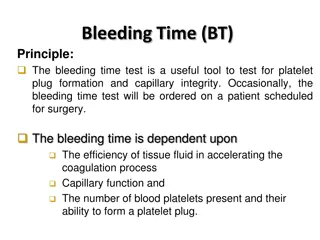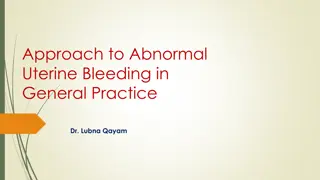Understanding Third Trimester Bleeding: Causes, Evaluation, and Management
Third trimester bleeding can be caused by various factors like placental abruption and previa, requiring prompt evaluation including assessing fetal heart rate and determining placental location. Different complications can arise for both the mother and fetus, necessitating specific management plans such as volume resuscitation and cesarean section delivery. Learn about the causes, symptoms, and interventions for third trimester bleeding in this comprehensive guide.
- Third Trimester Bleeding
- Placental Abruption
- Placental Previa
- Maternal Complications
- Fetal Complications
Download Presentation

Please find below an Image/Link to download the presentation.
The content on the website is provided AS IS for your information and personal use only. It may not be sold, licensed, or shared on other websites without obtaining consent from the author. Download presentation by click this link. If you encounter any issues during the download, it is possible that the publisher has removed the file from their server.
E N D
Presentation Transcript
Third Trimester Bleeding 433OBGYNteam@gmail.com
Objective: List the causes of third trimester bleeding . Describe the initial evaluation of a patient with third trimester bleeding . Differentiate the signs and symptoms of third trimester bleeding. List the maternal and fetal complications of placental previa and abruption placenta . Describe the initial evaluation and management plan for acute blood loss. List the indications and potential complications of blood product transfusion .
the causes of third trimester bleeding : 1. Apruptio placenta. 2. Placenta previa. 3. Vas previa. 4. Uterine rupture. 5. Preterm labor. 6. Vaginal or Cervical tear. 7. Cervical polyp. 8. Sever Cervicitis.
Intial evaluation = always assess fetal HR . ABC for cardio-pulmonary resuscitation and we ad another B for (baby) PPQRST (mnemonic for taking history) P= pain with bleeding Placental location Quantity of bleeding Recreational drugs Sex recently? Timing Physical examination Maternal vital signs (assess fetal heart rate , iv access ) Looking at skin for petechiae Palpate the uterus (soft, hard, tender) DO NOT PERFORMCERVICAL EXAMITION UNTILL PLACENTAL LOCTION HAS BEEN CONFIRMED Speculum examination
Placental Previa:- Complete Previa = completely covered the internal os Patial Previa = partially covered the internal os Low-lying placenta= exists when the placental edgs is near but not over the internal os. Classic presentation (painless vaginal bleeding) Diagnosed by ultrasound Management = volume resuscitation + betamethasone Method of delivery is cesarean section Complications : Bleeding from lower uterine segment Abnormal extension of placental tissue(Placenta accreta/increta/percreta)
Placental abruption:- Abnormal separation of the placental (vaginal bleeding+ abdominal pain) Couvelaire uterus is bleeding penetrates into the uterine myometrium forcing its way into the peritoneal cavity. Risk factors Trauma Cocaine use Hypertension Multiple gestations Diagnosed by clinical examination Management = fluids + delivery for sever hemorrhage
Massive blood transfusion : Is more than 10 units PRBC in 24 hrs. 1 unit PRBC = 200 cc red cells and rise HCT by 3-4% 1:1:1 = 1 unit PRBC , 1 unit FFP , 1 unit platelets When to transfuse? In massive hemorrhage In less acute we can depend on patient s health status and blood counts In general when Hb : 6-7= recommended 7-8 =Considered 8-10= If has symptoms of anemia Give RhoGam to Rh negative moms. Risk factor for blood transfusion: Infection, allergic or immune reaction, volume overload.
TEACHING CASE CASE: A 25-year-old G2P1 woman at 32 weeks gestation is brought to labor and delivery by her husband. About an hour before, she was watching television when she noted a sudden gush of bright red blood vaginally. The bleeding was heavy and soaked through her clothes, and she has continued to bleed since then. She denies any cramps or abdominal pain. She says that her last sexual intercourse was a week ago. A review of her prenatal chart finds nothing remarkable other than a borderline high blood pressure from her first prenatal visit that has not required medication. There is no mention of bleeding prior to this episode. She had an ultrasound to confirm pregnancy at 14 weeks, but none since. Physical examination reveals an extremely pale woman whose blood pressure is 98/60, pulse 130, respirations 30, temperature 99 F. Her abdomen is soft without guarding or rebound to palpation, and the uterus is nontender and firm, but not rigid. Fundal height is 33cm. Fetal heart tones are in the 140s with good variability. The external monitor reveals uterine irritability, but no discrete contractions are seen. There is a steady stream of bright red blood coming from her vagina.
1. What is your differential diagnosis for potential causes of bleeding for this patient? Placental abruption Placenta Previa Vasa Previa Genital lacerations/trauma (e.g. labial, vaginal or cervical) Foreign body Cervical/vaginal cancer Cervicitis Bloody show
2. What steps would you take to evaluate this patient? identifying the etiology of the bleeding, also evaluation of both the maternal and fetal status. - Assess maternal hemodynamic status: Serial vital signs Hematologic studies to assess for acute anemia and DIC Confirm placental location Avoid digital cervical exam Sonographic evaluation of placental location - Assess fetal status: Continuous external heart rate monitor or sonographic biophysical assessment Kleihauer-Betke test for maternal-fetal hemorrhage
3. What signs and symptoms would help you differentiate the potential causes of the bleeding? Placental abruption: Epidemiology: Separation of the placenta from the uterine wall prior to delivery of the fetus Occurs in 1 in 100 births Accounts for approximately 30% of cases of third trimester bleeding 25% recurrence risk in a subsequent pregnancy Risk factors: Hypertension (chronic or gestational) Cocaine use/smoking Abdominal trauma Sudden uterine decompression (as with rupture of membranes) Preterm premature rupture of membranes Clinical presentation: Frequent uterine contractions or hypertonicity Vaginal bleeding (sometimes catastrophic) Non-reassuring fetal heart rate tracing Hypofibrinogenemia supports the diagnosis Disseminated intravascular coagulation occurs in 10% to 20% of severe abruption
Placenta previa: Epidemiology: Occurs when placental tissue covers the cervical os. Central or total placenta previa placenta completely covers the os Partial placenta previa placenta partially covers the os (os must be partially dilated) Marginal previa - the placental edge is adjacent to the os, but does not cover it Low-lying placenta - the placenta approaches the os, but is not at its edge. At 24 weeks, about 1 pregnancy in 20 will demonstrate ultrasound evidence of a placenta previa At 40 weeks, the incidence decreases to 1 in 200 Accounts for approximately 20% of cases of third trimester bleeding Risk factors: Prior cesarean delivery History of myomectomy Increasing number of uterine curettages Increased parity Multiple gestation Advanced maternal age Smoking Clinical presentation: Bleeding is usually painless and may occur after intercourse Patients may also present with contractions, thus ultrasonography is critical to differentiating from abruption
Vasa previa: Epidemiology: Fetal vessels of a velamentous cord insertion cover the cervical os Incidence is less than 1% of all pregnancies Risk factors: Multiple gestations: up to 11% in twins and up to 95% in triplets Clinical presentation: The diagnosis is suggested by painless vaginal bleeding in the absence of evidence of placenta previa or abruption. Other causes: causes of 3rd trimester bleeding such as cervicitis, cervical erosions, trauma, cervical cancer, foreign body or even bloody show can usually be differentiated on physical exam once the preceding etiologies are ruled out.
4. What steps would you take to manage the low blood pressure and tachycardia that the patient is displaying? Ensure adequate airway and assess vitals Serial blood pressure, heart rate, and respirations Continuous oxygen saturation monitor Establish adequate IV access 2 large bore IVs or central venous line Monitor blood and coagulation profiles Serial CBC and platelet counts Serial prothrombin time, partial thromboplastin time, and fibrinogen Volume resuscitation Crystalloid Packed red blood cells Platelets, fresh frozen plasma and cryoprecipitate as indicated Monitor vitals and response to therapy: Serial blood pressure, heart rate, and respirations Continuous oxygen saturation monitor Continuous urine output assessment via indwelling Foley catheter Management of the patient with significant 3rd trimester hemorrhage, when the fetus is mature, is hemodynamic stabilization and delivery Vaginal delivery is generally precluded in the setting of abruption with persistent hemodynamic instability Cesarean delivery is required for all cases of previa and vasa previa
5. Under what circumstances would you consider blood product transfusion? Indications for blood product transfusion Acute blood loss of 30-40% blood volume Chronic blood loss with hemoglobin < 150 mg/dL Prolongation of PTT Platelets < 20,000 Platelets < 50,000 and cesarean delivery Blood products
Complications: Febrile non-hemolytic and chill-rigor reactions Acute hemolytic reaction due to ABO incompatible transfusion Delayed hemolytic transfusion reaction Transfusion-related acute lung injury Allergic reactions to unknown blood components Volume overload Graft vs. Host Disease (GVHD) Infectious complications (HIV, Hep B, Hep C, etc)
Done by: Budoor AlSalman Revised by: Razan AlDhahri























